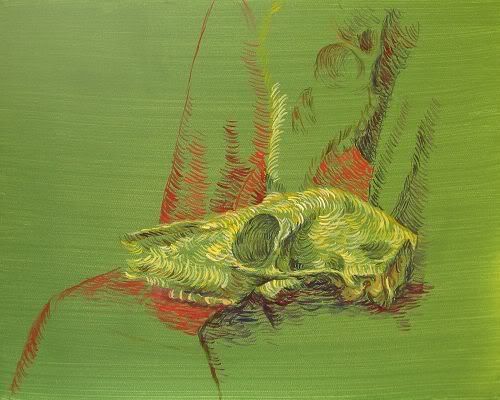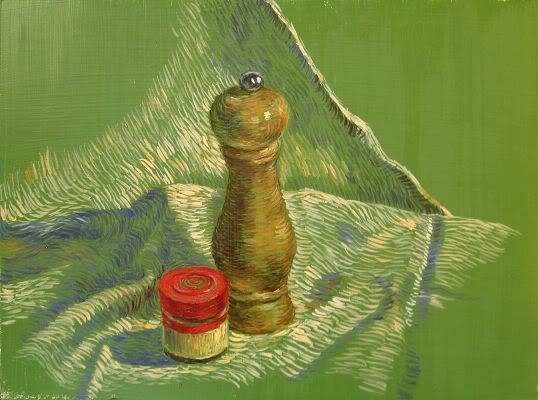
Okay, now we are learning the tempera technique. It's also called egg tempera. You use pigments mixed with egg yolk as a binding agent. We are still using oil paint, but paint with tempera technique, which is using tiny brushstroks to build up volume, texture and colors. To me it's more like drawing with brushes. Obviously this is a very slow and labor-intensive way to paint, but it's capable of achieving highly realistic effects.
上麵畫的是,好像是山羊頭骷髏?on drapery. 因為隻有一節課畫,隻夠畫了一個頭骨。
Egg tempera is the medium artists used before oil paints appeared and came into prominence. In the 20th century, there was a revival of tempera technique in western art. 比較著名的使用tempera 作畫的畫家有 Andrew Wyeth. 他的 Christina's World 相信大家都很熟悉。這幅畫就是用tempera 畫的。想想看,那麽一大片草地,都是用細筆一筆一筆畫出來的。這種技法畫頭發也特別好。

Andrew Wyeth. (American, born 1917). Christina's World. 1948. Tempera on gessoed panel, 32 1/4 x 47 3/4" (81.9 x 121.3 cm).

這個也是Andrew Wyeth的作品,也是tempera 畫法。 "Braids", 1979. Tempera. 16 1/2" x 20 1/2"
因為學習這個tempera 畫法,老師說最好嚐試一下在 masonite (一種硬木板)上畫。因為它表麵光滑, very conducive to this technique. 我也很有興趣嚐試一下。 我一直都是用 pre-primed canvas 或者canvas panel。
可折騰我了。 先去 Lowe's 沒有找到 Masonite, 再到我常去的一個美術用品店,他們也沒有賣的。又跑到 Home Depot. Then I got lucky. The nice lady I asked for help happened to be an artist, and she told me all about it. 原來 Home Depot 裏麵不把那叫masonite, 叫 tempered hardboard. 你可以買切好的小塊的,也可以買一大張,4 X 8 feet 的,然後切成你要的尺寸。
她問我:你有沒有鋸子?我說:沒有。頭大:我這五穀不分,四體不勤的人,原來還要做木工活? 她找了一個guy 幫我把板子取下來,然後幫我切。當然自己鋸最好了。別人恐怕都不會那麽耐心細致的量不同的尺寸。那個幫我鋸的人以為給我鋸幾下就好了,結果我讓他一會兒鋸成這個尺寸,一會兒鋸成那個尺寸,都不一樣。總算有了好幾塊我需要的大小,剩下的拿回家再說。其實這個還真是挺便宜。一整張木板才10塊錢,可以鋸成十幾塊來畫,比買現成的canvas 便宜多了。
回到家還有準備工作要做。 把木板表麵擦幹淨,用刷子蘸了 gesso (好像白色paint 一樣的東西,其實不是paint), 在表麵均勻刷一層。等它完全幹了,用sandpaper 磨光。當然不打磨也可以,如果你要texture的話。表麵擦幹淨,再用gesso 刷一遍,不同方向的。比如第一次橫著刷的,第二次就直著刷。等第二層gesso 幹了,再用砂紙打磨一遍,以讓表麵光滑。要刷至少兩層gesso, 有人刷更多層的。然後就可以用了!
但是等等,對我上的這門課來說,還有一道準備工續。就是用一種綠色,chromium oxide green, 把木板表麵再刷一遍,晾幹。The green color provides a middle tone for your painting. 這個是 verdaccio technique, 源於意大利。It's especially effective when painting flesh tones. 那什麽,達芬奇畫蒙娜麗莎的時候就是用的 verdaccio underpainting.

這個就是我在gessoed masonite 上畫的作業。我覺得還挺喜歡這種光滑的表麵的。canvas 比較有texture, 有tooth, 不太一樣。有的人不喜歡在木板上畫,覺得太光。我覺得不錯。尤其是因為它光,一開始如果哪裏畫錯的話,用paper towel 蘸點turpenoid, 一擦就全擦幹淨了。如果是canvas 還是多少會留些痕跡的。
Most of my classmates find temepra technique difficult. 因為我們都習慣用big brushes, just paint。但這個就是用小筆,#1 sable brush 一筆一筆畫,慢得很。It's a test of patience. 上節課一個同學提到凡高。我一邊畫一邊想,其實凡高的畫,他的pen and ink drawings, 還有paintings, 跟這個畫法很有相似之處。雖然他的brushstrokes 要大得多。
而且如果你先用一種顏色畫這些小線條,然後用另一種顏色畫,go in between the previous lines, the result 就是 optical mix. I think the impressionists borrowed from this old tempera technique and made it their own. 老師也說,when the impressionists saw Seurat's pointillism, it just opened doors for them. 不過他們把Seurat的點變成了線 (brushstorkes). In another sense, the impressionists (and the pointillists) engaged the audience more. A painting is not just done by the artist. A big part of the job is done in the viewer's eyes (through optical mix).
第一次老師教tempera, 我說:tempura? (重音在second syllable). 老師大叫:No! Tempura is the food! Tempera (重音在第一個syllable) is the painting technique. 厚厚。
回到家跟老公說tempera, 他也犯了同樣的錯誤。誰讓我們都愛吃Tempura. So I had the chance to correct him the same way as my teacher corrected me. 哈哈。




